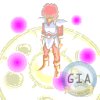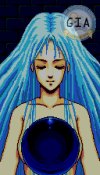
 |
|
As one of the first CD based console systems, the Turbo Grafx 16 CD offered developers the chance to exploit the potential of almost limitless storage capacity, often hundreds of times larger than competing cartridge based formats. Despite such lofty potentials, most simply didn't present gamers with something truly innovative, as they tended to be mediocre games disguised with exorbitant cut scenes and redbook audio. However, the trend would change in 1989 as Falcom released the remake of Ys I and II (prounounced 'ees'). Recieved with critical acclaim from both gaming and critic circles, Ys Book I and II: Ancient Ys Vanished would become an instant success. Unfortunately its Japanese success wouldn't be repeated as the TG CD's $500 price tag precluded Ys from reaching mainstream recognition. What separated Ys I&II from others in the pack was the way it perflectly fused a never before seen confluence of FMV and voice overs, a rich storyline and an enchantingly timeless redbook soundtrack. At the core, the story was told by converging all the merits of aesthetics, voice and audio, better than any competing game at the time. It was presentation at its finest. Perhaps this is why, even today, it is considered in may circles as one of the most influential and paradigm shifting games.
Despite being over a decade old, the story of Ys I/II still remains one of the most endearing of any game since, raising the bar for all future titles in terms of presentation and elegance. Set in a land of azure waters, the realm of Ys reached the height of its civilization under the guidance of its two Goddesses and six Priests. Unfortunately this serenity was shattered when the mysterious Black Pearl appeared and entranced the Goddesses and the Priests. Its alluring power promised an even greater prosperity. They gave in, and used the power of the Black Pearl to create the mineral Cleria. From nowhere, demons soon appeared and began to ravage the land and its people. Suspecting the Cleria to be the root of all evil, the Priests disposed of it by burying it deep within the ground. To make doubly sure that they were free of the evil, the Priests united their magic and lifted the land of Ys into the skies, where it vanished from sight and eventually from memory. Those who still talked about the realm of Ys merely thought of it as myth. Seven hundred years of peace came and went, till tragedy once again struck the land of Ys. The Cleria sealed centuries ago became unearthed and triggered the return of the ancient evil. The stage was set, as the legend of Ys was about to be retold.
Aiding the game's strong presentation are some of the most memorable characters to grace an RPG. Unlike the earlier incarnations of Final Fantasy or Dragon Warrior, Ys I&II was one of the first games to depart from the old standard of emotionless or indifferent characters. The Ys series revolves around its charismatic red-haired hero, Adol Christin, whose travels take him to the distant land Ys. Soon he is thrust into the land's history and troubles. In his arduous journey, he encounters characters who both aid and hinder his quest; Feena, the confused, immaculate girl found in the prison who soon finds an affinity for Adol; or Dark Fact, the villainous, yet almost regal magician controlling the land beneath; or Lilia, the recurring red-haired girl in the Ys series who has a keen eye for Adol; or Dalles, the servant to the most enigmatic of evils.
Despite being constrained by the limitations of its day, Ys I&II's aesthetics were none too shabby. Graphically it ran on an 8 bit graphic engine cloaked in a 16 bit mantle. While most RPGs of the time boasted dwarfish character sprites, Ys I&II embellished major dialogue sequences with the versatility of abundant anime cut scenes and voice acting. Reinforcing the game's presentation are the voices that helped to produce not only a charming, intricate storyline, but also showed that there were more interesting ways to tell a story than uninterrupted text. With a list that reads like a "Who's Who of Hollywood," the game's exceptional cast of voice actors include: Alan Oppenheimer (Transformers The Movie), Michael Bell (Legacy of Kain, Rugrats the Movie), Jim Cummings (Pokemon TV), Thomas Church (Wings TV), and Debbi Derryberry (Toy Story 2, Tenchi Muyo).
Its gameplay is highly reminiscent to Legend of Zelda. In typical adventure/RPG fashion, the view is usually overhead. Attacks are administered by simply bumping into the enemy. Unlike Zelda, there is no slash button, which seems to work against the game as it oversimplifies the gameplay. Oddly enough, once in the groove it's surprisingly fun to annihilate the wretched little monsters. Ys I&II started the "variable experience" system, setting a standard not only for the rest of the Ys series but many modern RPGs as well. Under the system, experience points are distributed based on your level; each time you gain a level the amount of experience rewarded by any given monster is reduced, thus hindering the player from becoming overly powerful in a given area.
Falcom's aural prowess has long been lauded by videogame music aficionados. Falcom rightly saw that words, voice and visuals can only go so far in any RPG experience, and that music would play an integral role in the genre. With Ys I&II, as in most Falcom games, music is the centerpiece. Involved in the composition and arrangement of the music were two industry giants, Koshiro and Yonemitsu. Yuzo Koshiro, known for his Actraiser I/II and Bare Knuckle soundtracks composed a number of songs, while Ryo Yonemitsu re-arranged the original composition. Its enduring soundtrack heavily fuses music of varied styles; from the guitar rock that only Falcom can do, to classical and techno. Highly memorable pieces like Theme of Adoru with its electric guitar and flute that beckons the player to arms, Palace with its haunting bell and piano score, or Last Moment of the Dark's brooding violins, all serve as a strong undercurrent to an already spectacular soundtrack.
Like most adventure/RPG games, Ys I&II won't take up much of your time. The average player should be able to finish it in about eight to fifteen hours. While it is a tad short, in a sense it serves as both a blessing and a curse. It is short enough so the game doesn't become drudgework, at the same time it is long enough to have produced a sense of distinct immersion. Though in the end, like any great game, you will definitely be craving more. Rest assured the game experience is as promising the second or even tenth time through as it is with the first. Ys Book I and II set a high and enduring watermark, influenced the game and music industry, and marked the evolution of the standard of how RPGs should be made. It was a game that combined simplicity and sophistication all in one package. However, the mark of a great game is the ability to unite all of its disparate elements, and at the same time provide an enjoyable experience. This game certainly does it better than most. If you're even remotely interested in playing one of the great unsung RPGs and seeing where most modern-day 'innovation' comes from, look no further than Ys I&II. Retrospective by Jeff Davis, freelance. |
|
|||||||||||||||||||||||||||||||||||||||||||||||||||






